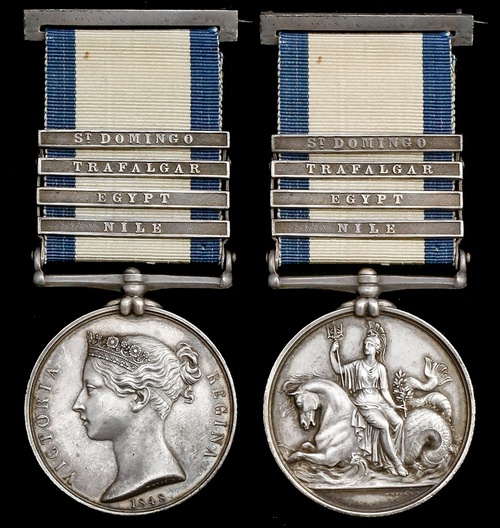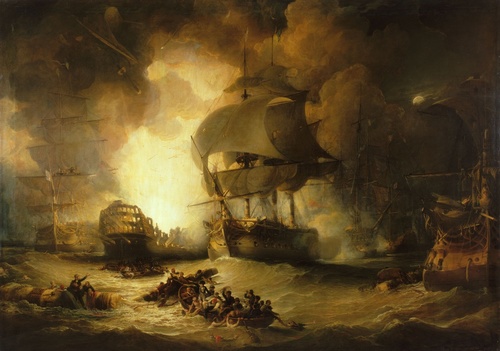Auction: 17003 - Orders, Decorations and Medals
Lot: 423
The unique Naval General Service Medal awarded to Lieutenant A. F. Parr, Royal Navy, who first saw action as an 11-year-old Midshipman at the battle of the Nile in 1798, when his ship - H.M.S. Swiftsure - was largely responsible for effecting the spectacular destruction of the French flagship L'Orient
He was subsequently chosen by Lord Keith to accompany the operations off Egypt in H.M.S. Penelope in 1801 and he was still serving as Midshipman - and a teenager - at the time of his participation in the battle of Trafalgar aboard H.M.S. Agamemnon in 1805
Parr won his Lieutenancy for his part in the action off St. Domingo in 1806 - a rare accolade indeed for a 19-year-old - and continued to lend valuable service until coming ashore in 1816
Naval General Service 1793-1840, 4 clasps, Nile, Egypt, Trafalgar, St. Domingo (A. F. Parr, Midshipman), original riband with upper silver brooch-bar for wearing, good very fine
Provenance: Ex-A. A. Purves collection, Christie's, 12 November 1992 (Lot 5). The sale was publicised in both the New York Times and London Evening Standard.
The published rolls confirm the recipient's presence at the battle of the Nile, as a Midshipman aboard H.M.S. Swiftsure; and, likewise, aboard H.M.S. Agamemnon at Trafalgar and St. Domingo; no roll survives for the Egypt operations but he was clearly present at the landings at Aboukir Bay aboard H.M.S. Penelope in March 1801: his four-clasp award is unique.
Alexander Forsyth Parr was born on 7 October 1786, the scion of a distinguished naval family:
'His father, a veteran Gunner, entered the service in 1777 and died in 1840 at the advanced age of 85. He had served in seven ships of war under 30 different Admirals and Captains: he had been on board the Swiftsure 74 when captured by the French in June 1801; and on board the Venerable 74 when wrecked in Torbay in November 1804. One of Lieutenant Parr's brothers died a Midshipman at Guadaloupe in 1790; two other were also in the R.N. - the first as a Commander, the second a Lieutenant; and a fourth died as Deputy Assistant Commissary-General in the Army at George Town, Demerara' (O'Byrne's Naval Biographical Dictionary, refers).
Young Alexander commenced his career with an appointment as a Third Class Volunteer aboard H.M.S. Swiftsure in October 1796; his father was at the time likewise embarked as Gunner.
The Nile
In late July 1798, as the search for the French Fleet continued apace, Captain Benjamin Hallowell of the Swiftsure was ordered to reconnoitre Alexandria. As a result the Swiftsure did not reach the scene of battle at Aboukir Bay on 1 August until darkness had fallen.
Hallowell took Swiftsure in across the stern of Franklin and the bow of L'Orient, and proceeded to hotly engage them. After an hour of exchanging shots, a fire was observed in the cabin of L'Orient. Hallowell ordered his men to concentrate their guns on this area, while H.M.S. Alexander came along the opposite side and did the same. The French began to abandon ship as the fire spread, and a number were brought aboard Swiftsure, including L'Orient's First Lieutenant and ten ratings. Seeing that the fire was now out of control, Swiftsure and her consorts moved away from the area, but when L'Orient exploded in spectacular style at 10 p.m. Swiftsure was still near enough to be struck by flying debris.
After the destruction of the French flagship, Swiftsure, in company with H.M.S. Defence, continued to exchange fire with the Franklin, until she surrendered. She then moved on to engage the Tonnant, eventually helping to drive her ashore.
Swiftsure had seven killed and 22 wounded during the battle. Hallowell received the Gold Medal for his role in the battle, and Swiftsure's First Lieutenant, Thomas Cowan, was promoted to Commander. After the battle Hallowell and Swiftsure took over Aboukir Island on 8 August, destroying several enemy guns, and carrying the rest away. Two days later, on 10 August, she came across, and captured the 16-gun corvette Fortune.
Ongoing operations off Egypt and Italy
Swiftsure remained off Egypt until mid-February 1799, when she joined Nelson at Palermo. She next joined Sir Thomas Troubridge's squadron and sailed for Naples on 31 March. The squadron arrived on 2 April, and Hallowell landed at Procida to restore monarchist rule. The squadron then cruised off the Italian coast, and supported land based operations, helping to reduce several fortresses.
Afterwards becoming the flagship of Sir Richard Bickerton, and having participated in the blockade of Cadiz, Swiftsure was assigned to the fleet under Lord Keith. The Admiral's fleet subsequently covered the landings at Aboukir on 8 March 1801, where Swiftsure's naval brigade helped to repulse French counter-attacks. Because several of her men were wounded and others sick, Keith removed 80 of Swiftsure's best men - including Midshipman Parr - to his own ship, H.M.S. Penelope.
Having returned home and been paid-off in May 1802, Parr gained an appointment aboard H.M.S. Wasp in the summer of 1803. He subsequently served off Portugal and in the Mediterranean, and, as cited by O'Byrne, suffered severe lacerations to his right leg whilst on duty aloft in November 1804. He returned to England in the following year and came ashore 'for the purpose of passing his examination'.
Trafalgar
Parr next joined Nelson's old command, H.M.S. Agamemnon, a ship the famous Admiral had described as 'the finest 64 in the service'. She would shortly share in the crowning victory at Trafalgar. MacKenzie's Trafalgar Roll takes up the story:
On 13 October [1805] Agamemnon joined Lord Nelson off Cadiz with Sir Edward Berry, Bart., as captain, and, during the pursuit of the enemy, very nearly fell into their hands. On the morning of the 20th, the day before the great battle, with a prize - a heavy French merchant brig - in tow, she was unconsciously running into the midst of the enemy's ships, but eventually got clear. In the weather column she fought at Trafalgar, and was a good deal engaged with Dumanoir's division. Her losses amounted to ten killed and wounded and she received a nasty wound under the quarter, which kept her pumps constantly going.'
O'Byrne quotes an account of Parr distinguishing himself in the immediate wake of the battle:
'He was sent on board the Colossus 74, to ascertain the state of that ship, and so dilapidated did it prove to be that Agamemnon was under the necessity of taking her in tow. During the long and disastrous gale which shortly afterwards arose, the rope that connected the two vessels unfortunately broke, and the Colossus was in imminent danger of being driven on shore and utterly lost. In order to prevent if possible a catastrophe so awful, it was determined by Sir Edward Berry, notwithstanding the risk, that a boat should lowered for the purpose of passing a fresh rope to the distressed ship, and of thus again taking her in tow. We have only to add that the execution of the hazardous enterprise was confided to, and most ably accomplished by, Mr. Parr.'
St. Domingo and beyond
Parr next distinguished himself in the action off St. Domingo on 6 February 1806, when Agamemnon suffered casualties of 14 killed or wounded. He was promoted to Lieutenant on the same occasion.
He was next present at the capture of La Lutine, and in the operations connected with the expedition to Copenhagen. On the fall of the latter place, he aided in navigating to England, as second-in-command, the Danish 74-gun ship Princess Caroline, with the 95th Regiment embarked.
On rejoining the Agamemnon, he sailed for South America, where, while filling the post of First Lieutenant, he was wrecked in the Rio de la Plata on 20 June 1809. O'Byrne states:
'So great were the exertions he underwent on the occasion, that, on being received on board Bedford 74, he sank into a state of complete exhaustion, and, from the effects of inflammation produced in the eyes, was for eighteen days deprived of the power of sight.'
In the previous year he had suffered a severe wound to his forehead, following an explosion of powder aboard Agamemnon.
In July 1810, Parr joined the Argo as First Lieutenant and was employed in that capacity in protecting convoys to the River St. Lawrence, to the coasts of Portugal and Spain, and to the Mediterranean. Being superseded from the Argo - at his own request - in November 1813, he was nominated captain of the Alpheus in May 1814, in which ship he served in the East Indies before coming ashore for a final time in December 1816.
In April 1831, Parr was attached to the Royal Hospital at Haslar, and he died there in 1856, aged 70.
Subject to 20% VAT on Buyer’s Premium. For more information please view Terms and Conditions for Buyers.
Sold for
£18,000







